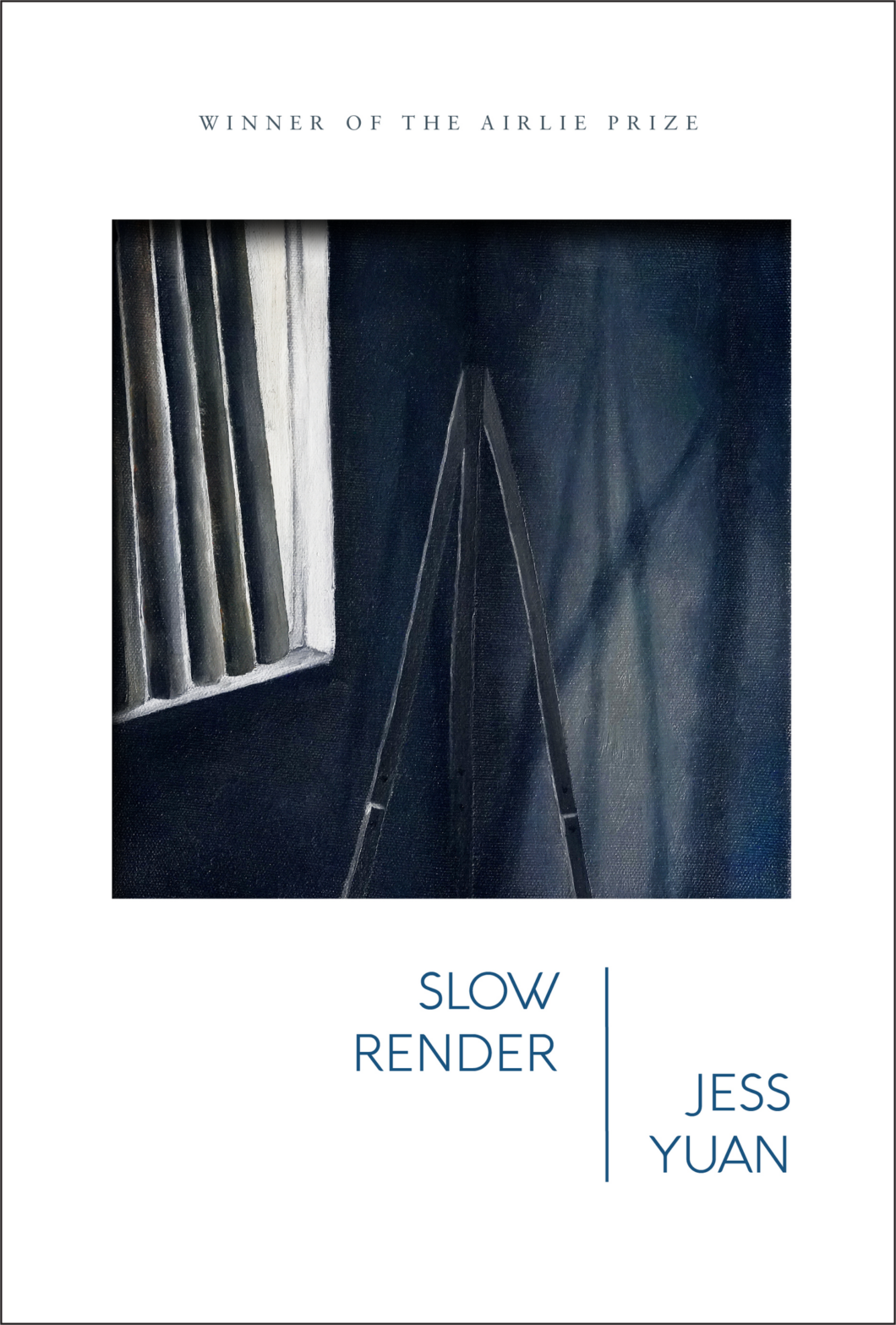Jess Yuan’s Slow Render–winner of the 2022 Airlie Prize for poetry–is situated in a pre-post-truth world where capitalism, imperialism, and technology are still calculable and grieved on human terms, at a human scale. With the keen eye of an architect, Yuan organizes her first full-length collection and the speaker’s lyric unlayering in three parts, resulting in a decomposition where we encounter the speaker’s gradual derealization in tandem with our own. Yuan manages to reinvigorate and complicate the lyric tradition with renderings of human spaces—from the micro to the macro—which feel bodied and bodily. In the same way that a bird’s nest is a form of technology, so too feel the human structures of Yuan’s book. In this slightly younger world, full of ‘90s childhood allusions, tractable invention, and fathomable human error, Yuan traces each intersection and transaction; each tracing becomes a lens through which to digest our current world—its loss, disconnect, and devastation.
One project of Slow Render is the speaker’s accumulating solastalgia, an attitude we arrive at via the collection’s unswerving voyeurism–an ocular fixation keenly aware of human invention and capable of penetrating human structures. From early contrivances of the x-ray to Butades’ daughter’s invention of painting, Yuan’s poems are compelled not only to track innovation but also its consequences. Nothing is immune to Yuan’s speaker’s tender skepticism, who observes of the inventor, “once he saw through the first thing / he could steal the depth from anything.” This awareness is equally brought to the searching gaze of the poem—“if poetry is the shadow of X / across your body of language / if only X could choose what passes through.” Transparency, then, is problematic but is also a vestige of a simpler time, an era “which still celebrated the honesty of glass,” favored “a small economy of brush and grasses”, and came before the collection’s present tense, wherein “[t]he power grids never quite fail anymore.” The overall gaze of the book moves from the macro to the micro; the opening poem locates us in “the mythology / of an earth just beginning / to revolve around / something else” while subsequent poems move into progressively smaller revolutions around family, childhood, and the speaker’s own embodied state.
It is Yuan’s particular kind of looking which effortlessly superimposes architecture onto human bodies and humanity onto architecture, so that at times it is unclear what kind of form is appearing—human or nonhuman. Whether it’s “slicing symmetry down / from the belly’s dome,” a “belt of power / line,” or the speaker passing “the wide smooth scar / of concrete,” human spaces are portrayed somatically, so that the reverberations of human action are felt by the entire environment. In this animate macrocosm, landfills are “cresting with memory,” the landscape “up to its asphalt belt with violent blue shade.” The effect of this is myriad—because the poems are so populated, Slow Render’s speaker moves seamlessly in and out of the forefront, at times preoccupied with their own actions and, at other moments, deprioritizing the lyric to center non-human or human-adjacent perspectives, a swerve in attention that borders on a kind of animism. Even outside, the poems often enter linguistically humanized spaces. Yet even outside, the poems often enter linguistically humanized spaces: “where River strokes / the esophageal hollow”, “memory sinks / a pale thread of root”, or the “curb licked clean”, “[b]ody’s width of water / meek in the light…” It is in these moments where the poems feel the most radical, critical, and expansive—that Slow Render might lend us a form of looking through which we may ultimately be able to see beyond ourselves.
Moving from the past toward an imagined future, the speaker’s hindsight enacts a language which has been affected by what’s to come. In contrast to modernity’s obsessive looking, “in childhood the land was not transparent. / The canyon was lush with opacity, a screen of quivering two-sided leaves…” At various points, Yuan’s speaker chronicles the material imports of imperialism with something akin to nostalgia for those “simple[r] exchanges”—“[t]elescopes, self-sounding clocks, / new maps and instruments appear / unobtrusively…” Yet, as the poems aggregate, nostalgia turns to self-implication turns to warning. Yuan’s speaker seems increasingly concerned with a kind of embodied disconnect, even self-deploring in moments such as confessing to inverting “two ziplock bags / over my hands to meet the hefty worm…but would not / touch its body.” Or, in another moment, countering this choice with: “to taste the nuance of real dirt / i neglect the recipe.” This struggle—between personal values and the contagious momentum of the times, solidifies the speaker’s relatability and believability, culminating in a shared sense of critical exhaustion which, on an average day, may feel familiar to most. The speaker concedes, “I am writing with great embarrassment,” comparing the work (of the poem, of any agent of capitalism) to that of the silkworm, who fabricates silk “not for the love it it,” but whose hard work is “boiled / and boiled to such soft uses.” Yuan takes this image one step further, writing “[i]s the revolutionary the worm or the moth? / Is my work the thread or its undoing?”
Through Slow Render’s ongoing accounting and examination, the text gradually aggregates toward macro societal diagnoses and predictions. Yuan’s speaker reminds us of the promises many of us have only just shed—promises of a recent but increasingly distant world, where we lived “hoping they have thought this part through, / considered the costs / and chose this form for the world, / chose it clearly,” but where instead “they” mindlessly mine the earth—“hit ruin and export ruin” “enough to doubt / what we anchored to that century.” How does one come to terms with the gap between these two realities? What happens to the body? Of the poem, of the speaker, of the land? Yuan asks: “[h]ow to keep inventory…How to knit together the worst of what’s coming” and, in answering, shifts into a projected space and time where “[e]verything in the museum is the valence / of a terrified future. Daylight collapsed / into a flowing screen.”
Yet the collection is not without hope. The “work” may be redeeming after all, for as Yuan writes, “[t]hat is why even the most how-has-it-come-to-this world / still has someone like me in the lobby, still able to speak of the future.” Yuan’s gaze, though unwavering, is “not deciding,” emphatic instead of “telling you / how hard we all try.” It is through this effort that we can–or must–still access beauty, just as the silkworm digests the mulberry leaves no matter the outcome of its silk. Ultimately, Slow Render sets its sights on “praise, which must be thrown there, to the quivering strand / of life…” Though it may not be enough that a thing is simply built—an x-ray machine, a bridge, a nation—that we may locate ourselves inside this greater organism may be both inevitable and even natural, our technologies no more invasive or inhuman than we allow them to be. If there is a chance to find agency in the vacuous tide of ecocide, capitalism, and imperialism, Slow Render is a gorgeous attempt at its location.
Yuan, Jess. Slow Render. April 2024. 74 pages. $18.00

